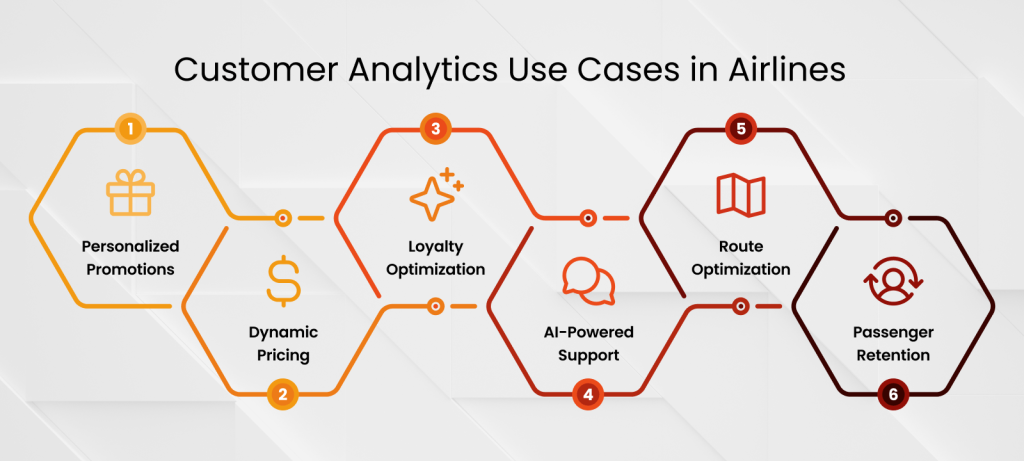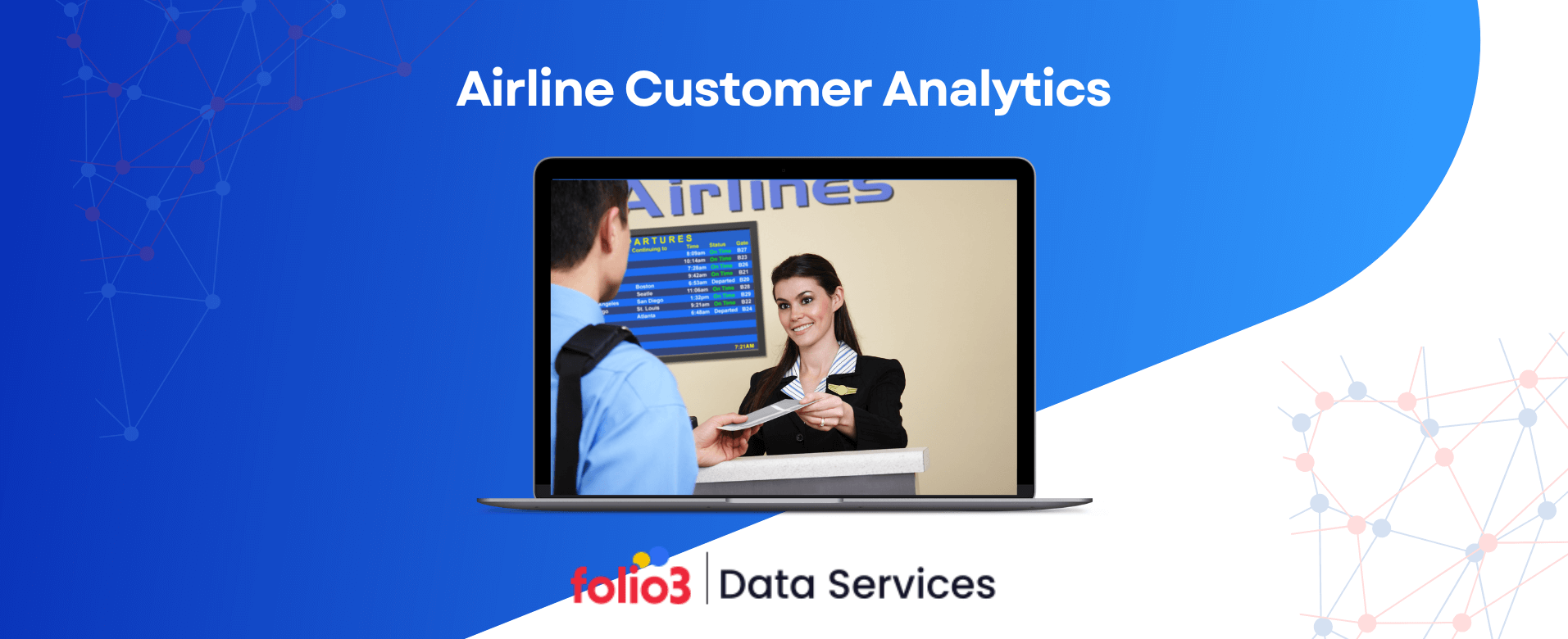In a sector where even a slight edge can make a massive difference, airlines are doubling down on data to outfly the competition. The global airline industry has become fiercely competitive with increasing pressure to enhance profitability, retain loyal passengers, and manage rising operational costs. Major carriers are not just competing on routes or ticket prices anymore—they’re competing on insights.
Passenger expectations have also evolved. Today’s travelers demand more than on-time departures and comfy seats. They want personalized offers, seamless digital experiences, and services tailored to their preferences. This is where airline customer analytics takes center stage—helping carriers understand behavior, predict needs, and deliver targeted experiences that build loyalty and drive revenue.
So, what is airline customer analytics? Simply put, it’s the practice of gathering, processing, and interpreting passenger data to improve the customer journey at every touchpoint—from booking and check-in to in-flight services and post-travel feedback.
By using data analytics in the airline industry, carriers can craft tailored marketing strategies, improve seat pricing models, and even anticipate customer complaints before they happen. Global airline passenger traffic in January 2025 surged by 16.6% compared to last year. This rebound amplifies the urgency for airlines to harness insights from big data analytics in the airline industry to stay competitive.
Use Cases of Customer Analytics in Airlines
With the sheer volume of traveler data generated across websites, apps, in-flight systems, and customer support channels, airlines are increasingly using airline customer analytics to gain a deeper understanding of individual behaviors and preferences. Data analytics consulting plays a critical role in helping airlines make sense of this massive data pool, translating insights into practical strategies that enhance the passenger experience, optimize operations, and increase profitability.
Below are six high-impact use cases, each illustrating how data analytics in the airline industry is reshaping modern aviation.

1. Personalized Marketing and Promotions
Gone are the days of one-size-fits-all travel deals. Airlines now use customer segmentation and behavioral data to deliver targeted campaigns that actually resonate.
Example: Delta Air Lines uses its SkyMiles data to offer customized promotions based on travel history, preferred destinations, and booking behavior. If a customer frequently travels to New York for business on weekdays, Delta might offer a limited-time discount on flights to JFK departing Monday mornings. These insights are pulled from past bookings, online searches, and even abandoned carts.
According to McKinsey, personalized communication can drive 5 to 15% increases in revenue and 10 to 30% increases in marketing efficiency. For airlines operating on razor-thin margins, this is no small win.
By using airline customer analytics, airlines can also retarget dormant customers with enticing offers or alert loyal passengers to exclusive perks, keeping engagement high without excessive promotional spending.
2. Dynamic Pricing Strategies
One of the most financially powerful applications of analytics lies in pricing. Airlines are now using advanced models to continuously adjust fares based on real-time factors such as demand trends, competitor pricing, seat availability, and booking patterns.
Example: Lufthansa employs dynamic pricing algorithms that adjust fares across its network based on booking windows and passenger behavior. A frequent flyer who often books last-minute business class seats will likely see higher prices compared to a leisure traveler booking months in advance.
These models are built using big data analytics in the airline industry, pulling from sources like social media trends, weather forecasts, and even regional economic data to predict when and where passengers are most likely to book. This helps airlines maximize revenue per seat without alienating price-sensitive travelers, often with the guidance of expert data strategy services.
3. Optimizing Loyalty Programs
Loyalty programs aren’t just about handing out miles—they’re strategic tools for retention and upselling when fueled by analytics.
Example: Emirates revamped its Skywards program by analyzing customer spending habits beyond flight tickets—such as duty-free purchases, hotel bookings, and car rentals. Based on this data, Emirates started offering more relevant rewards and personalized offers, making the program more attractive to high-value customers.
Using data analytics in the airline industry, airlines can identify which perks matter most to different customer groups. For example, business travelers might prioritize lounge access or flexible booking, while leisure travelers may value hotel discounts or family benefits.
Airlines can also use predictive models to forecast when a loyal passenger may be close to switching carriers and respond with proactive incentives—an approach that’s both cost-effective and impactful.
4. Enhancing Customer Service with AI Chatbots and Virtual Assistants
Real-time support is now an expectation, not a luxury. Many airlines have embraced AI-powered chatbots to resolve issues quickly and deliver smoother travel experiences.
Example: KLM Royal Dutch Airlines has implemented a chatbot that handles everything from check-in reminders to baggage information and flight status updates. The chatbot learns from previous interactions and adapts over time to provide more accurate, context-sensitive responses.
While this does incorporate AI, the foundation is still airline customer analytics—gathering and analyzing data from past queries, pain points, and service records. This allows airlines to reduce wait times, cut down call center costs, and provide passengers with support that feels human and timely.
Chatbots can also be trained to upsell services such as seat upgrades or extra baggage based on customer history, blending service with smart monetization—guided by a refined data analytics strategy.
5. Route and Schedule Optimization Based on Passenger Demand
Deciding which routes to operate and how frequently to fly them is a major challenge—especially as travel patterns fluctuate due to global events, fuel costs, and economic shifts. Analytics helps airlines make data-driven decisions that balance profitability with passenger demand.
Example: During the pandemic recovery, United Airlines used customer data and demand forecasting to reopen routes gradually, starting with domestic leisure destinations like Florida and Hawaii before restoring international business travel corridors. They analyzed booking patterns, search traffic, and even vaccination rates to prioritize routes with the highest potential yield.
This level of agility would not be possible without the power of big data analytics in the airline industry. Data helps optimize not just which cities to serve, but the aircraft type to deploy, the flight frequency, and even seasonal timing—ensuring better load factors and improved operational efficiency.
6. Identifying At-Risk Passengers and Preemptive Engagement
Not every customer is loyal. Some are price shoppers; others leave due to poor service. Analytics helps airlines identify when a customer is about to churn—so they can intervene before it’s too late.
Example: American Airlines uses a churn prediction model that flags frequent flyers who haven’t booked in several months or have had repeated service issues (like delays or mishandled baggage). The system then triggers a recovery campaign—such as a discount on their favorite route or a complimentary upgrade offer.
By analyzing ticketing patterns, survey data, and even social media sentiment, airlines can spot dissatisfaction early. This proactive engagement, rooted in airline customer analytics, can mean the difference between losing a customer forever or bringing them back into the fold with a well-timed nudge.
Let’s Turn Data Into Loyalty—Personalized, Predictive, and Profitable Customer Insights.
Benefits of Customer Analytics for Airlines
The airline industry has never been short on challenges—high operating costs, fluctuating fuel prices, stiff competition, and increasingly demanding passengers are just a few factors making it one of the most dynamic and competitive sectors in the world. In this landscape, relying on guesswork or generic service models is no longer viable. Instead, data has become a critical tool in shaping strategic decisions, particularly when it comes to improving the customer experience.
As mentioned earlier, airline customer analytics is the process of collecting and analyzing traveler data to better understand passenger behavior, preferences, and needs. Whether it’s through mobile apps, loyalty programs, call centers, or booking platforms, every interaction provides insights that airlines can use to create more personalized, efficient, and profitable experiences.
Here are some of the key benefits that airlines are gaining by putting data analytics in the airline industry to work:

1. Increased Customer Satisfaction and Loyalty
When travelers feel seen and valued, they return. Personalization—rooted in smart data use—has become a major driver of customer satisfaction. From recommending ideal travel times based on a passenger’s routine to suggesting seat upgrades tailored to previous choices, airlines are using data to improve every aspect of the journey.
Example: Singapore Airlines is known for its top-tier service, and part of that is fueled by how it analyzes customer feedback and loyalty data. For instance, if a frequent flyer regularly selects vegetarian meals, the system remembers this across flights, ensuring a seamless experience.
This level of personalization matters. 73% of travelers expect brands to understand their unique needs. By using airline customer analytics to meet these expectations, airlines are building trust and encouraging repeat bookings—key drivers of long-term success in a highly competitive market.
2. Improved Revenue per Passenger
Beyond satisfaction, customer analytics directly impacts the bottom line. Airlines are finding that the better they understand their passengers, the more revenue they can generate per seat.
Through big data analytics in the airline industry, airlines are identifying profitable cross-selling and upselling opportunities—from lounge access and extra baggage to car rentals and travel insurance. These are not random offers; they are based on past behavior, preferences, and booking patterns.
Example: Ryanair uses customer data to promote ancillary services like hotel bookings and priority boarding in a way that matches individual traveler habits. It’s no coincidence that Ryanair earns over 30% of its total revenue from ancillary services alone. By aligning offers with what customers are most likely to accept, airlines can lift average revenue per user without pressuring them into unnecessary purchases.
3. Enhanced Operational Decision-Making
Customer analytics isn’t limited to just marketing or sales—it plays a significant role in operational efficiency as well. By mapping the entire passenger journey, airlines can spot friction points and address them proactively.
Example: JetBlue analyzes customer service logs, flight delays, and in-flight feedback to detect patterns. If certain routes consistently receive negative service ratings, leadership investigates further—whether it’s a crew issue, catering flaw, or delay trend.
This kind of visibility allows airlines to take data-backed actions to fix service gaps before they snowball into reputation damage. With the help of data analytics in the airline industry, even backend decisions—such as where to allocate more staff or when to offer automatic rebooking during weather disruptions—can be optimized with greater accuracy.
4. Reduced Churn and Improved Retention
Airline switching is easy in the digital age, and customers who have one bad experience may never return. However, the same data that helps personalize experiences can also flag unhappy passengers before they walk away.
Example: Alaska Airlines tracks sentiment data from surveys and social media to flag high-value customers showing signs of dissatisfaction. These passengers are then targeted with personalized outreach—discount codes, apologies, or loyalty point bonuses. It’s a proactive approach rooted in real insights, not assumptions.
In fact, a study by Bain & Company found that increasing customer retention rates by just 5% can boost profits by up to 25%. By using airline customer analytics to monitor behavior changes—such as fewer bookings, reduced spending, or frequent complaints—airlines can take action before it’s too late.
5. Better Demand Forecasting and Resource Allocation
Accurate forecasting is vital for managing routes, staffing, catering, and aircraft utilization. Airlines that understand customer booking behaviors, seasonality, and external factors like local events can better plan resources and reduce waste.
Example: During the 2024 Summer Olympics in Paris, Air France used predictive analytics to adjust capacity on specific routes from North America and Asia, anticipating a surge in demand. The result? Higher load factors and fewer last-minute operational changes.
With big data analytics in the airline industry, airlines can integrate data from bookings, loyalty programs, airport check-ins, and even Google search trends to forecast demand with impressive precision. This leads to more efficient aircraft deployment, smarter scheduling, and cost savings in areas like fuel, catering, and crew management.
Conclusion
In an industry as cutthroat as aviation, data isn’t just helpful—it’s essential. Personalized customer experiences, improved profitability, and operational agility are all outcomes of smart data practices. And as customer expectations continue to rise, airlines that fail to embrace airline customer analytics risk falling behind.
Whether it’s reducing churn or launching a new route with confidence, the insights airlines gain through data analytics in the airline industry will only grow more valuable as technology evolves. Those who invest in understanding their passengers—rather than just moving them—will be the ones that thrive in the next era of air travel.



